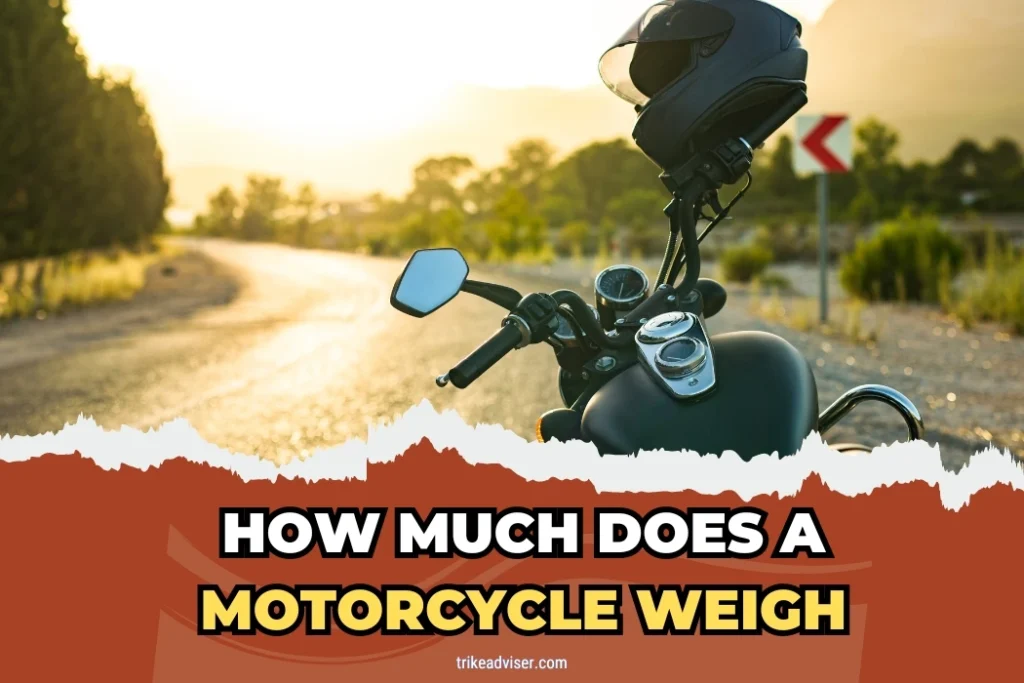Picking the right motorcycle isn’t just about the color or brand. It’s about weight, too. Think it doesn’t matter? It does. Your ride’s weight impacts everything – from handling to fuel efficiency.
Light or heavy, each has its place. But which fits your journey? Imagine hauling a heavyweight bike on a twisty mountain road. Or, a lightweight one, struggling on a windy highway.
Confusing, right? Here’s how to cut through the fog. Ask yourself two things: What’s my riding style? Am I often on long, adventurous trips, or city-bound?
How much does a motorcycle weigh
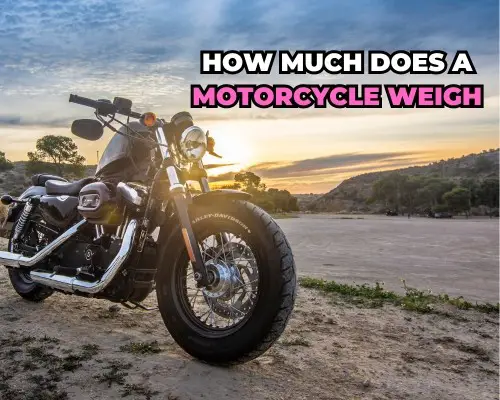
The Basics: More Than Just Numbers
Consider yourself lusting after that stylish motorcycle and dreaming of wide-open spaces. But the weight of it is a very significant question.
Motorcycle weights varied widely, from a light 300 pounds on average to a heavy 500 pounds. This range isn’t, however, arbitrary.
It’s a mirror of what’s underneath, your ride’s heart and soul. Factors Adding Weight: The Inside Story
- Engines and Exhausts: Think of the engine as the motorcycle’s beating heart. Larger hearts, larger bodies. A bigger engine not only adds power but also pounds.
- Brakes and Rims: It’s about the details. Heavier brakes and steel rims (over aluminum) add significant weight. Ever wondered why your bike feels so planted? Here’s your answer.
- Model Variations: Take the iconic Harley-Davidsons, for example. They can weigh anywhere between 540 and 905 pounds. Each model is a different beast, tailored for specific roads and riders.
The Heavyweights: Giants on the Road
Imagine setting off on a cross-country journey, your motorcycle a steadfast companion. Power cruisers, designed for such adventures, can weigh a staggering 800 to 1,000 pounds.
These machines aren’t just about size; they’re about endurance, comfort, and the promise of horizons unseen.
Dry vs. Wet Weight: A Tale of Two Weights
- Dry Weight: The bike alone, no fluids. It’s like meeting someone for the first time; you see them, but you don’t yet know them.
- Wet Weight: Add in the fluids, and now you’re acquainted. This is the bike ready for the journey, full tank and all. It’s essential to consider both, especially if you’re meticulous about performance and handling.
Lightening the Load: Crafting Your Ride
Dreaming of a lighter, zippier ride? Here’s how:
- Upgrade Your Parts: Switching to a lighter battery or opting for aluminum sprockets can make a world of difference. It’s like shedding layers before a sprint.
- Declutter: Removing non-essential parts is not just about aesthetics; it’s about agility. It’s about making your motorcycle an extension of your will on the road.
The Basics of Motorcycle Weight
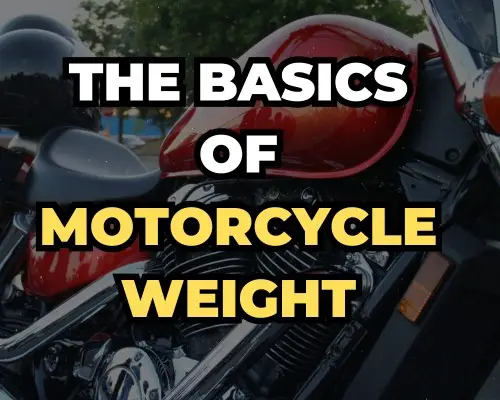
Choosing the appropriate motorcycle is similar to packing for an exciting trip. You consider your needs and possibilities before making a decision.
However, just when you believe you understand everything, you find out there’s more to motorcycle weight than meets the eye.
Average Weight Ranges by Motorcycle Type: Beyond the Scale
Chopper: At 500 – 800 pounds, choppers are the heavy hitters. They’re like the solid, dependable friend who’s always there, stable and strong, making every ride a statement.
Adventure Bikes: With weights of 330 – 600 pounds, these are your Swiss Army knives on wheels. They’re adaptable and ready for anything, much like that multi-tool you can’t travel without.
Dirt Bikes: Featherweights at approximately 215 pounds, zip and zoom with the ease of a mountain goat on rugged terrain. They bring back the excitement of carefree, quick jogging.
Touring Bikes: At 400–1000 pounds, these monstrosities are the size of an opulent RV. They transport your entire universe with them and provide the smoothest trip across the furthest distances.
The athletes of the road are sport motorcycles, which weigh between 280 and 530 pounds and are designed for speed and agility. When you race on a track, you get a rush from the wind in your face and your heart rushing.
Scooters: Capable of maneuvering through traffic like a dancer, these 150–300 pound scooters are your go-to city navigators.
Factors Influencing Motorcycle Weight: The Craft Behind the Scenes
Engine Size: Like choosing between a powerful but heavy DSLR and a compact, light smartphone camera. Both capture moments, but the choice affects how you carry them through your day.
Materials Used: The transition from heavy metal to lightweight carbon fiber in motorcycle frames is akin to the shift from bulky winter coats to sleek thermal wear. Innovation makes the ride smoother and less burdensome.
Intended Use: Just as you’d select a sturdy backpack for hiking or a sleek suitcase for business travel, the purpose of a motorcycle heavily influences its design and, consequently, its weight.
Onboard Equipment: Adding features to a motorcycle is like packing your bag with gadgets and gizmos for a trip. Each addition has its use but also adds weight, affecting how you navigate your journey.
CCs (Cubic Centimeters): The engine’s CCs are not just about power but also about the weight it adds to the bike. It’s the balancing act between wanting more horsepower and managing the extra weight, similar to deciding how much tech to pack for a trip without weighing yourself down.
The Weight is Worth It
Understanding the weight of your motorcycle goes beyond simple numbers; it’s about how it fits into your life and adventures.
Like that moment when I realized my duffle was overpacked, choosing a motorcycle involves understanding not just what you need but also what you can handle.
It’s about the joy in the journey and finding the perfect balance that makes every ride, no matter how heavy or light, just right.
The Heavyweights: Touring and Cruiser Bikes – A Rider’s Insight
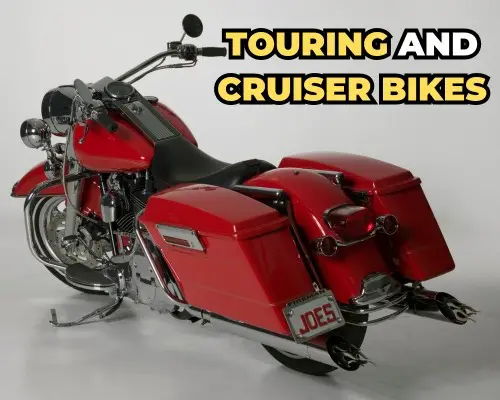
Controlling a heavyweight motorcycle—a touring or cruiser bike, for example—is like steering a ship across broad waters. It combines strength, grace, and a hint of daring.
Having spent countless miles atop these giants, I’ve come to understand their character and the nuanced dance of riding them.
Characteristics of Heavyweight Motorcycles: The Heart and Soul
- Engine Size: There’s a profound difference between twisting the throttle on a heavyweight and anything else. It’s not just acceleration—it’s a surge of power that propels you forward as if the very essence of the journey is encapsulated in that moment.
- Frame: Riding a bike with a frame designed to carry more than just speed, but also dreams and aspirations, feels like wearing a bespoke suit. It fits; it’s comfortable; it’s meant to be.
- Storage: Setting off with everything you need, stored within the bike’s cavernous compartments, provides a sense of independence. It’s the motorcycle equivalent of a turtle carrying its home, yet far more majestic.
- Performance: The sheer capability to maintain grace under load, to accelerate smoothly, and to embrace the horizon is exhilarating. It transforms long rides from mere travel to an exploration.
- Comfort: There’s something to be said about a ride so comfortable that hours in the saddle feel like moments. Adjustable features and ergonomic designs make the world feel softer, more welcoming.
Benefits of Riding Heavyweight Motorcycles: Beyond the Brochure
- Power and Performance: The thrill of harnessing such power underlines every ride. It’s not just moving from point A to B; it’s about the stories woven between.
- Comfort: Comfort on these machines is unparalleled. Imagine settling into a ride where the journey itself becomes a part of the joy, not just the destination.
- Storage: The freedom to pack without compromise, to carry along not just necessities but also those little extras that make the trip memorable, is liberating.
Challenges of Riding Heavyweight Motorcycles: The Rider’s Burden
- Weight: Learning to manage the heft of a heavyweight bike is a journey in itself. It’s about finding balance in motion and the sweet spot in every turn, much like learning to balance the responsibilities of life itself.
- Maintenance: With complexity comes the necessity for attention. Each bolt, each component demands respect and care, echoing the need to tend to the details in our lives for smoother journeys.
- Customization: The temptation to personalize is strong, yet each addition asks something of you in return. It’s a lesson in moderation and understanding the essence of what truly matters.
Lightweight Champions – Sports and Dirt Bikes
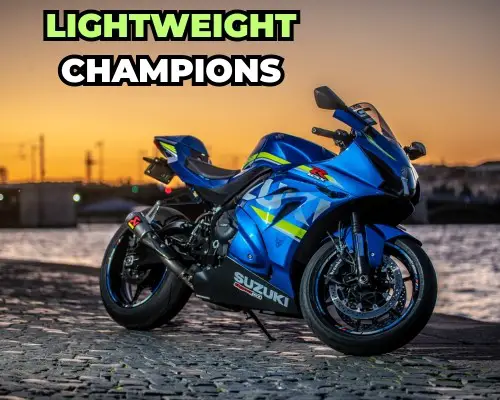
Riding lightweight motorbikes requires experience in the arts of agility and finesse, whether they are tough dirt bikes or nimble sports bikes.
My experience with these agile machines has demonstrated the excitement of mastery and served as a lesson in humility.
Features of Lightweight Motorcycles: Crafting Speed and Precision
Lightweight Frame: I was astounded by the sports bike’s lightweight frame’s inventiveness the first time I lifted one for maintenance.
It’s not only about cutting weight; it’s about building a machine that becomes a true extension of the rider, reacting to even the smallest cues.
Narrow Tires: I learned the value of accuracy while riding a dirt bike across wild terrain thanks to its narrow, tread-heavy tires. Each tire is a promise of grip and control on terrain that demands respect and attention.
Minimalistic Design: Stripping down to essentials isn’t just an aesthetic choice; it’s a philosophy. Every unnecessary part removed is like shedding weight from your backpack before a climb – liberating.
Plastic Components: The use of plastic over metal is a game-changer. I remember the first time I swapped out parts; the difference in speed was palpable as if the bike had shed its earthly tether.
Narrower Seat: The narrower seat, while not the epitome of comfort, positions the rider for optimal control. It’s a reminder that in pursuit of our passions, comfort often takes a backseat to performance and experience.
Advantages of a Lighter Bike on Performance and Maneuverability
Improved Handling: The agility of a lightweight bike in the throes of a tight turn is nothing short of exhilarating. It’s like the bike reads your mind, responding to the slightest inputs with grace and immediacy.
Improved Agility: Being able to accelerate and change directions quickly isn’t only about being fast; it’s also about experiencing an unrestricted freedom that sends your heart racing and your soul soaring.
Greater Fuel Efficiency: A lightweight bike’s economy is not only cost-effective but also environmentally friendly. Longer rides on less fuel mean more adventures with a smaller footprint.
Reduced Rider Fatigue: Less weight to manage means you can ride longer, explore further, and push the boundaries of your endurance. It’s about finishing a day’s ride energized, not exhausted.
The Essence of Riding Light
The sensation of oneness with my bike—a lightweight marvel that felt like an extension of my body—was more important to me throughout that ride than the speed or intensity with which I rode. That was an epiphany—a sign that lighter really may mean more when it comes to motorcycles.
Understanding the delicate balance between rider and ride, power and precision, is just as important as enjoying the excitement of riding these machines. It is similar to a dance in that it teaches you about your boundaries and how to go beyond them.
As an Amazon Associate, I earn from qualifying purchases, at no additional cost to you. Read Our Affiliate Disclosure.

